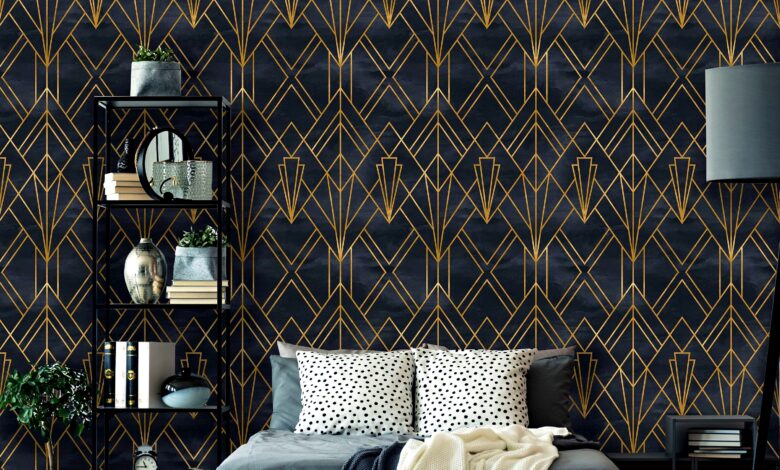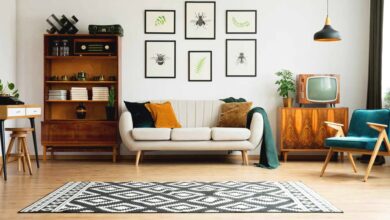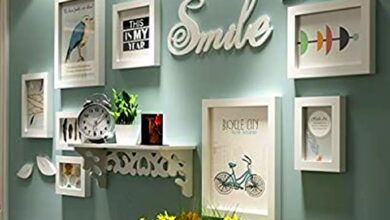How to Use Peel-and-Stick Wallpaper Like a Designer
In this comprehensive guide, we’ll explore how to use peel-and-stick wallpaper like a designer to elevate your home’s aesthetic.

Peel-and-stick wallpaper has revolutionized home decor, offering an accessible, renter-friendly, and budget-conscious way to transform spaces with style and flair. Unlike traditional wallpaper, peel-and-stick wallpaper is easy to apply, remove, and reposition, making it a favorite among DIY enthusiasts and professional designers alike. In this comprehensive guide, we’ll explore how to use peel-and-stick wallpaper like a designer to elevate your home’s aesthetic. From choosing the perfect design to mastering application techniques, we’ll cover everything you need to know to achieve professional-quality results.
What Is Peel-and-Stick Wallpaper?
Peel-and-stick wallpaper, also known as removable wallpaper, is a self-adhesive wall covering that doesn’t require glue, paste, or professional installation. Made from vinyl or fabric-backed materials, it adheres to surfaces with a low-tack adhesive, allowing for easy application and removal without damaging walls. This makes peel-and-stick wallpaper ideal for renters, homeowners looking for temporary decor solutions, or anyone who loves refreshing their space frequently.
With endless patterns, textures, and colors, peel-and-stick wallpaper offers versatility for any room, from bold accent walls to subtle, sophisticated designs. Its affordability and ease of use have made it a go-to choice for modern interior design projects.
Why Choose Peel-and-Stick Wallpaper?
Before diving into the how-to, let’s explore why peel-and-stick wallpaper is a designer’s dream:
- Ease of Installation: No messy glue or professional help needed—just peel, stick, and smooth.
- Removability: Perfect for renters or those who change their decor often, as it leaves no residue.
- Versatility: Available in countless designs, from florals to geometrics, it suits any style.
- Cost-Effective: Peel-and-stick wallpaper is often more affordable than traditional wallpaper.
- DIY-Friendly: Even beginners can achieve stunning results with minimal tools.
With these benefits in mind, let’s dive into how to use peel-and-stick wallpaper like a designer to create a space that feels curated and intentional.
Step 1: Plan Your Peel-and-Stick Wallpaper Project
Define Your Vision
Designers approach peel-and-stick wallpaper with a clear vision. Start by identifying the room and purpose of your project. Are you creating a bold accent wall in your living room? Adding texture to a bathroom? Or refreshing a nursery with playful patterns? Your goal will guide your design choices.
Consider the room’s existing color palette, furniture, and lighting. Peel-and-stick wallpaper should complement, not compete with, your space. For example, a minimalist bedroom might benefit from a subtle, textured peel-and-stick wallpaper, while a vibrant kitchen could handle a colorful geometric pattern.
Choose the Right Wall
Not every wall is ideal for peel-and-stick wallpaper. Designers often select a focal point, such as:
- Accent Walls: Behind a bed, sofa, or dining table to draw attention.
- Small Spaces: Powder rooms, closets, or entryways for a big impact in a compact area.
- Furniture Backdrops: The back of bookshelves or cabinet interiors for a pop of personality.
Measure your chosen wall carefully to determine how much peel-and-stick wallpaper you’ll need. Most rolls come in standard widths (18–24 inches) and lengths, so calculate the square footage to avoid waste or shortages.
Select the Perfect Peel-and-Stick Wallpaper Design
Designers know that the right pattern can make or break a room. When choosing peel-and-stick wallpaper, consider:
- Scale: Large patterns work well in spacious rooms, while smaller patterns suit compact spaces.
- Color: Bold colors create drama, while neutrals offer timeless elegance.
- Texture: Faux textures like linen, wood, or brick add depth without overwhelming.
- Style: Match the wallpaper to your aesthetic—bohemian, modern, vintage, or eclectic.
For example, a tropical peel-and-stick wallpaper with oversized palm leaves can bring a vacation vibe to a sunroom, while a metallic geometric design adds sophistication to a home office. Browse reputable brands like Tempaper, RoomMates, or Chasing Paper for high-quality options.
Gather Your Tools
To apply peel-and-stick wallpaper like a designer, you’ll need:
- Measuring tape
- Level or straightedge
- Utility knife or scissors
- Smoothing tool (credit card or plastic smoother)
- Pencil for marking
- Step ladder (for tall walls)
- Cleaning supplies (isopropyl alcohol, cloth)
Having these tools ready ensures a smooth, professional installation process.
Step 2: Prepare Your Surface for Peel-and-Stick Wallpaper
Designers know that preparation is key to flawless results. Peel-and-stick wallpaper adheres best to clean, smooth, and primed surfaces. Follow these steps:
- Clean the Wall: Wipe the wall with isopropyl alcohol or a mild cleaner to remove dust, grease, or fingerprints. Let it dry completely.
- Smooth Imperfections: Sand down any rough spots or fill small holes with spackle. Peel-and-stick wallpaper won’t hide major imperfections, so ensure the surface is even.
- Prime if Necessary: For textured or porous walls (like drywall), apply a primer to improve adhesion. Avoid glossy paints, as they can reduce stickiness.
- Test a Small Piece: Before committing, apply a small piece of peel-and-stick wallpaper to ensure it sticks well and removes cleanly.
Pro Tip: Designers avoid applying peel-and-stick wallpaper in high-humidity areas like steamy bathrooms unless the product is specifically labeled as moisture-resistant.
Step 3: Master the Application Process
Here’s where the magic happens. Applying peel-and-stick wallpaper like a designer requires precision and patience. Follow these steps for a seamless finish:
Measure and Cut
- Measure the height and width of your wall.
- Cut your peel-and-stick wallpaper into manageable strips, adding an extra 2–3 inches to each strip for adjustments.
- If your wallpaper has a repeating pattern, align the design before cutting to ensure continuity.
Start with a Straight Line
Designers use a level to ensure their first strip is perfectly vertical, as even a slight tilt can throw off the entire project. Mark a straight line on the wall with a pencil and level, starting from a corner or the center of the wall.
Apply the First Strip
- Peel back about 6 inches of the backing from the top of your first strip.
- Align the strip with your marked line, leaving a slight overhang at the top for trimming.
- Press the exposed adhesive to the wall, smoothing from the center outward to avoid bubbles.
- Gradually peel away the backing as you smooth the strip downward.
Smooth and Adjust
Use a smoothing tool to press the peel-and-stick wallpaper firmly against the wall, working out any air bubbles. If you notice misalignment, gently lift and reposition the strip—another perk of peel-and-stick wallpaper’s forgiving nature.
Match Patterns
For patterned peel-and-stick wallpaper, align each new strip with the previous one to maintain a seamless design. Overlap the edges slightly (about 1/16 inch) to avoid gaps. Trim excess at corners, baseboards, and ceilings with a utility knife for a clean edge.
Handle Obstacles
For outlets, switches, or windows, apply the peel-and-stick wallpaper over the obstacle, then carefully cut around it with a utility knife. Smooth the edges for a polished look.
Step 4: Maintain and Remove Peel-and-Stick Wallpaper
Maintenance Tips
To keep your peel-and-stick wallpaper looking fresh:
- Dust regularly with a soft cloth or vacuum with a brush attachment.
- Spot-clean with a damp cloth and mild soap, avoiding excessive water.
- Avoid direct heat sources, as they can weaken the adhesive.
Removal Process
One of the biggest advantages of peel-and-stick wallpaper is its easy removal. To remove:
- Start at a corner and gently peel back the wallpaper at a 45-degree angle.
- Pull slowly to avoid tearing or leaving adhesive residue.
- If adhesive remains, wipe the wall with a damp cloth or adhesive remover.
Always test removal on a small area first to ensure your wall stays intact.
Common Mistakes to Avoid
Even designers make mistakes, but you can avoid these pitfalls:
- Skipping Prep: Failing to clean or prime the wall can lead to poor adhesion.
- Misaligning Patterns: Not matching patterns creates a disjointed look.
- Rushing Application: Take your time to avoid bubbles or wrinkles.
- Overstretching: Pulling the wallpaper too tightly can distort the design.
Designer Tips
- Start Small: If you’re new to peel-and-stick wallpaper, begin with a small project like a powder room or bookshelf.
- Mix and Match: Combine different peel-and-stick wallpaper patterns in the same room for an eclectic vibe, but ensure they share a common color or theme.
- Sample First: Order samples to test colors and patterns in your lighting before committing.
- Think Long-Term: Choose a design you’ll love for years, even if it’s removable.
Wallpaper Trends for 2025
Stay ahead of the curve with these designer-approved trends:
- Biophilic Designs: Nature-inspired peel-and-stick wallpaper with botanicals or landscapes.
- Textured Looks: Faux wood, stone, or linen textures for a tactile feel.
- Bold Geometrics: Large-scale shapes in vibrant colors for modern spaces.
- Metallics: Gold, silver, or copper accents for a touch of glamour.
Where to Buy High-Quality Peel-and-Stick Wallpaper
Top retailers for peel-and-stick wallpaper include:
- Tempaper: Known for chic, renter-friendly designs.
- RoomMates: Offers budget-friendly, high-quality options.
- Chasing Paper: Features collaborations with designers for unique patterns.
- Etsy: Great for custom and small-batch peel-and-stick wallpaper.
- West Elm: Curates trendy, sophisticated designs.
Always check reviews and product specs to ensure the wallpaper suits your needs.
Conclusion
Using peel-and-stick wallpaper like a designer is all about planning, precision, and creativity. By choosing the right design, preparing your surface, applying with care, and styling thoughtfully, you can transform any space into a work of art. Whether you’re refreshing a single wall or experimenting with furniture makeovers, peel-and-stick wallpaper offers endless possibilities to express your style. With its ease of use and stunning results, it’s no wonder designers and DIYers alike are obsessed with this versatile decor solution.











